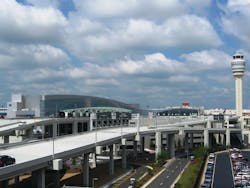Built to Last
Pullquotes:
Facility Condition Index (FCI) is a benchmark calculated as the ratio of deferred maintenance dollars to replacement dollars that provides a straightforward comparison of an organization’s key assets and deferred maintenance costs.
... management needed to see accurate data in a readily understood and accessible format in order to identify the needs of the portfolio and justify budget requests.
In 1925, an abandoned auto racetrack became the site of Atlanta's first airfield. In the years since, that airfield has evolved into Hartsfield-Jackson Atlanta International Airport (ATL), the world’s busiest airport serving more than 95 million passengers a year.
Calling this bustling airport “large” is also an understatement. Airport facilities cover more than 13 million square feet, including 39 ticket counter positions, 10 domestic gates, 28 international gates, and areas dedicated to the entertainment and comfort of the passengers. Hundreds of vendors provide food, retail and relaxation services along the gates.
Hartsfield-Jackson also holds the title as the largest employer in Georgia, employing more than 58,000 people in a variety of positions. And, to top it off the airport has a direct economic impact of more than $32.5 billion in the metro Atlanta area.
Despite the monumental size of its operations, however, Hartsfield-Jackson remains a leader in both airport efficiency and customer service. But like any leader, even this finely tuned “machine” faces challenges. And one major challenge has been managing the enormous facility portfolio of such an important economic and employment driver in the region. The airport’s Aviation Asset Management and Sustainability (AMS) Division was challenged to keep track of the properties they owned and the condition of the facilities. Short- and long-term funding needs were not clear because the AMS Division often lacked sufficient data on the age, condition and cost of both deferred maintenance and replacement for facilities and systems. Without this insight, AMS employees were forced to be more reactionary than strategic.
It was clear that management needed to see accurate data in a readily understood and accessible format in order to identify the needs of the portfolio and justify budget requests. It was determined that an asset management and maintenance program would help the AMS Division reduce deferred maintenance, improve facility condition across the portfolio, and project accurate life cycles of systems. Such a system would help them answer the following questions:
- What do we own?
- How long do we want it to last?
- Who is responsible for maintaining it?
- What is the age, condition and cost to replace?
- What are our funding needs -- short- and long-term?
Hartsfield-Jackson turned to VFA, a Boston, Mass.-based provider of facilities capital planning and management solutions, to help manage its built assets.
Data is King
VFA and the AMS team began by importing and modeling existing data. The process started with crafting a database to house information on all airport buildings and infrastructure, modeling them according to typical life cycles. Asset information, such as use, construction type, year constructed, year renovated, size, location and condition was then imported and recorded. Data on asset systems, including roofing, mechanical equipment, interior finishes, plumbing, and electrical was also recorded. Requirements for deferred maintenance were recorded by due date, category (for example, code compliance, environmental, functionality) and asset system, and then classified by priority, ranging from 1 to 5. (1 –Currently Critical, 2 – Potentially Critical, 3 – Necessary Not Yet Critical, 4 – Recommended, 5 – Does Not Meet Current Codes/Standards.)
VFA entered 644 assets into this database as part of Hartsfield-Jackson’s asset registry. They also modeled 194 actual buildings along with 3,400+ systems in building areas covering 13.5 million square feet with an average age of 22.3 years. Another 6.6 million square feet of parking lot was also modeled, with an average age of 16.8 years.
Buildings were then sorted by Facility Condition Index (FCI), a benchmark calculated as the ratio of deferred maintenance dollars to replacement dollars that provides a straightforward comparison of an organization’s key assets and deferred maintenance costs.
Systems were sorted by Highest Needs and Highest System Condition Indices to prioritize projects. A list of recommended actions with cost estimates was produced. Yearly funding needs were projected out 10 years, and “what-if” scenarios were used to demonstrate the impact of various funding strategies on facility condition.
The AMS Division is now able to produce an Executive Scorecard that shows the FCI for various areas of the airport, the estimated costs of renewal, funding scenarios, and other key information that can be easily viewed and interpreted by Hartsfield-Jackson management. Reports can be pulled in a matter of minutes on any of the airport’s assets.
Hartsfield-Jackson recently began using a mobile software solution for facility condition assessments conducted by AMS Division staff, which enables users to access the system and important data on the fly. The ability allows for a frequent, consistent data flow, and keeps the data more accurate and up to date. In addition, by using a standard process and data format, the data is consistent throughout no matter who captures the information.
Hartsfield-Jackson's capital management program helps to maintain the vision of the AMS Division, which is to lead the Department of Aviation’s focus on renewal and replacement of aging infrastructure and to prioritize future capital investment based on life cycle analysis, total cost of ownership, and sustainable development. With a manageable facility portfolio and accurate, up-to-date data, the AMS Division can ensure the world's busiest airport is built to last.
BIO: William Pharris is the senior facility assets manager at Hartsfield-Jackson International Airport.
